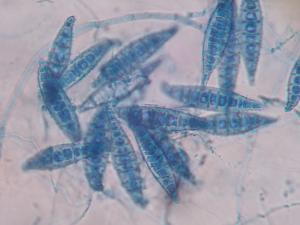Ringworm in Dogs and Cats
- posted: Sep. 02, 2017
 Ringworm in Dogs and Cats
Ringworm in Dogs and Cats
Ringworm is not a worm as the name suggests but rather a skin infection caused by several species of fungus that can infect dogs, cats and people. Ringworm can be transmitted by contact with infected animals or people or can be found in soil.
Ringworm typically causes circular, crusted areas of hair loss on the skin and the lesions may be itchy. The condition is best diagnosed by a fungal culture—a few hairs are plucked from a lesion and placed on a gel plate that will change color from yellow to red within 7-10 days if fungal organisms are present. A special type of black light called a Wood’s Lamp may also be used to diagnose some species of ringworm fungus or dermatophytes. Certain species glow a bright apple green under the light. Once in a while, cats may be carriers of the fungus, but not show any outward clinical signs.
Ringworm can be treated in several ways. If there are only a few localized lesions, a topical antifungal cream may be applied daily for several weeks to the affected areas. If the lesions are covering large areas of the body, anti-fungal shampoos and/or antifungal pills may be used to treat the patient. Because it is contagious, all household pets may need to be treated and special decontamination of the house and environment may be necessary. Unaffected pets in a multi-pet household may need to be isolated from those affected and receiving treatment.
Ringworm is often devastating if it affects animals in a shelter or breeding facility, but it is manageable in a home situation. However, pets may need to be treated for as long as eight weeks and humans should use good hygiene when handling affected pets. Wash your hands after handling pets with ringworm and do not sleep with or cuddle infected cats or dogs. Immune compromised individuals should not handle pets with ringworm. Pets should have a fungal culture repeated at the end of the course of treatment to ensure the infection is resolved.
This blog brought to you by the Patton Veterinary Hospital serving Red Lion, York and the surrounding communities.
Source: Clinician’s Brief, August 2017
Location
Patton Veterinary Hospital
425 E Broadway
Red Lion, PA 17356
